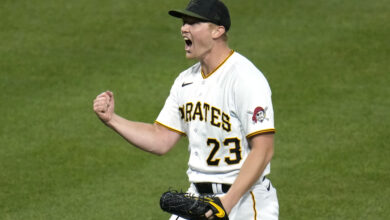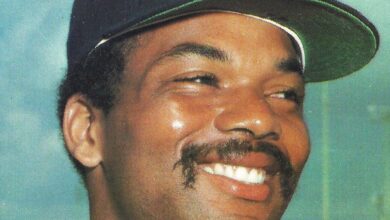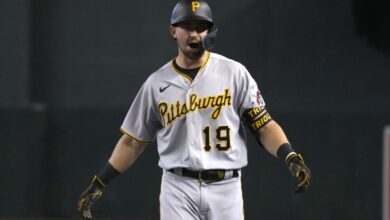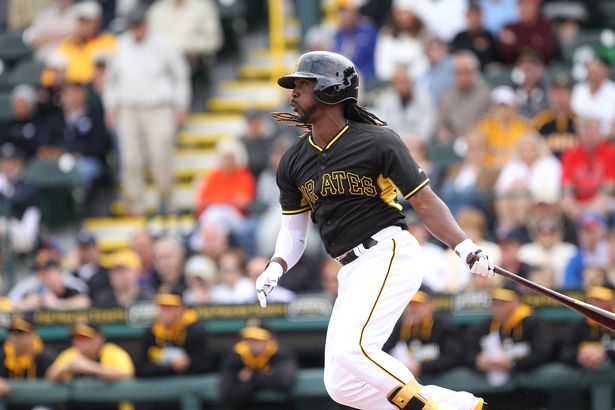
July 23, 1968. The Cincinnati Reds entered the bottom of the ninth inning at old Forbes Field with a 5-3 lead over the home team Pittsburgh Pirates and right-handed submarine bullpen ace Ted Abernathy on the mound. With one out, Abernathy walked third baseman Jose Pagan, who was hitting .191 at the time. With the pitcher’s spot due up, Pirates manager Larry Shepard sent 37-year-old player/coach Bill Virdon to the plate.
The left-handed batting Virdon had retired as a player after the 1965 season and was coaching first base under Shepard. He had been reactivated as a player eight days previous. In Virdon’s only plate appearance since being reactivated, the Mets’ Ron Taylor struck him out with the tying run on second base to end a game. This time, Abernathy fell behind in the count, 3-1. He came in with a fastball and Virdon sent it high over the right-field screen for a game-tying homer. The fans in attendance, which included his wife and daughters, gave him a standing ovation.
Gentleman Bill
In the days before the internet, I found Virdon’s entry in The Baseball Encyclopedia to be curious. It showed he hadn’t played at all in 1966 and 1967. Then in 1968, he played six games, batted three times and had one hit, which was a home run. I wrote to him, care of the Pirates, and asked about it. Virdon replied that they were caught short because of players serving military duty. He said the home run tied the game, but the Pirates lost in the 11th inning. (Actually, it was the 12th inning.) He was too much of a gentleman to name the pitcher.
When the 1965 season concluded, Virdon was 34 years old. For that season, he had slashed .279/.322/.370, in line with his career numbers of .267/.316/.379. He was three years removed from winning the Gold Glove Award but could still chase ‘em down in center field. He was worth four Defensive Runs Saved in 1965. Although those figures were down from his prime years 1957-1960, his range factors were around National League average.
His premature retirement shocked general manager Joe L. Brown. It was rumored Virdon wanted to get away from manager Harry Walker. There always seemed to be turmoil during Walker’s tenure as Pirates manager. Many Pirates players, used to his predecessor Danny Murtaugh’s calm demeanor, didn’t like playing for Walker. Again, Virdon was too classy to air his dirty laundry in public. He simply stated that he wanted to get started on a future career in managing.
Desperation sets in
After two years as a manager in the New York Mets’ minor league system, he returned to Pittsburgh to serve as a major league coach in 1968. In May, Brown, Shepard and his coaches were sitting in Brown’s Chicago hotel room, brainstorming ways to improve the team. Virdon said he thought he could still play if they wanted to reactivate him. Shepard opposed the idea, feeling it reeked of desperation.
By July, things had changed. Shortstop Freddie Patek went on the disabled list, as it was then called, with a broken bone in his wrist. It was a time when the United States still had a draft. Ballplayers were required to leave their teams for a week or so to serve military duty. (Can you imagine Alex Rodriguez serving military duty? Me neither.) The Pirates’ system had 18 players on military duty. Their triple-A team in Columbus had no extra infielders or outfielders. One of their players, veteran utility infielder Andre Rodgers had a sore arm.
Not so embarrassing
Suddenly, the notion of reactivating Virdon didn’t seem so far-fetched. There was precedent for the move, too. In 1965, the Pirates reactivated coach Hal Smith and coaxed him into catching four games, even though he had retired in 1961 due to a heart condition. (This wasn’t the same Hal Smith who was a catcher for the Pirates in 1960-61.) Virdon had been keeping himself in shape by taking infield practice with the players since rejoining the Pirates.
Brown and Shepard feared fan backlash, but they had no other choice. Shepard told Charley Feeney of the Pittsburgh Post-Gazette, “I will use him late in a game, on defense, or as a pinch-hitter. Bill still will coach at first base. I have no intentions of starting Bill in a game.” Feeney called the move “a bit embarrassing.”
Nobody with the Pirates was embarrassed when Virdon connected against Abernathy. “I had him in a hole and he knew it,” Virdon told Les Biederman of The Pittsburgh Press. “Abernathy thought I might be taking that pitch and he was just trying to get it over. But the moment I connected, I felt it was gone.”
Living the dream
Virdon, thought to be heir apparent to the Pirates’ manager job when Shepard was hired, would eventually realize his dream. He would manage the Pirates (1972-73), New York Yankees (1974-75), Houston Astros (1975-82) and Montreal Expos (1983-84). He’s the answer to the trivia question, which Yankees manager never managed a game in Yankee Stadium? (Yankee Stadium was being renovated in 1974-75 and the Yankees’ home games were played at Shea Stadium.) He returned to the Pirates as a coach to assist managers Jim Leyland and “Legendary” Lloyd McClendon.
While coaching for McClendon, Virdon was among a group of Pirates coaches who conducted a clinic at our local Little League field. When Virdon was done with my son’s group, he approached me and started a discussion. (Can you imagine Barry Bonds doing that? Me neither.) We walked to our cars together. He didn’t know I had written to him when he singled me out. That was part of the appeal of the 1960 World Champion Pirates, why they are the most beloved of all Pittsburgh championship teams. Besides ending a 35-year championship drought in Pittsburgh, they were regular guys.





